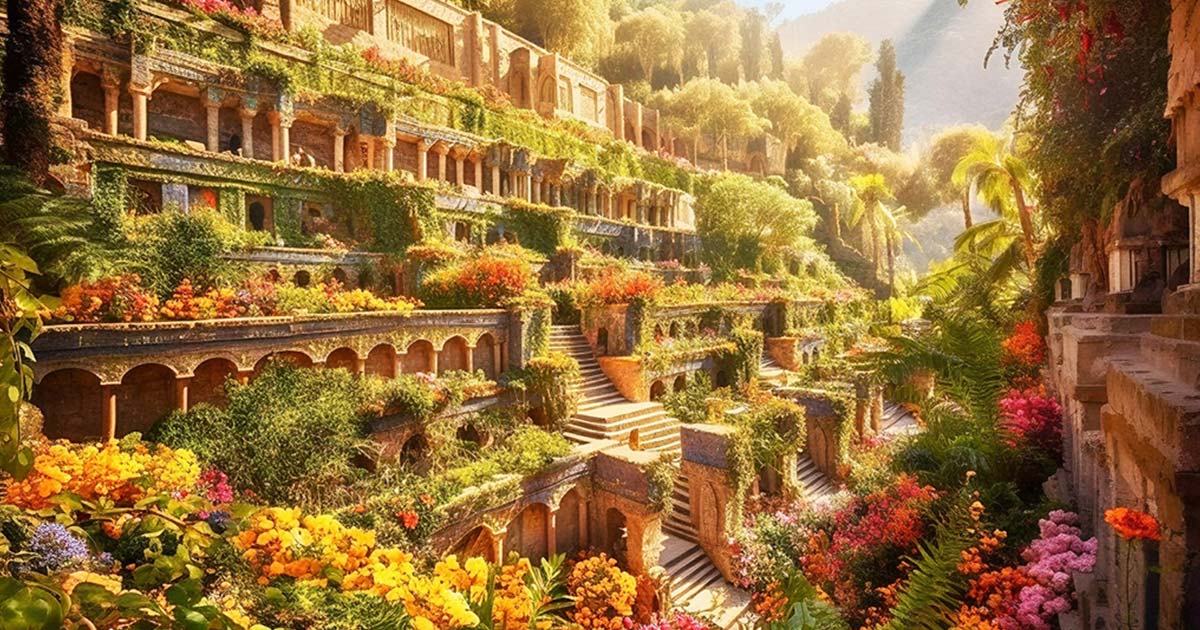
Greek and Roman literature vividly describe the opulent Hanging Gardens of Babylon. Amidst the hot, arid terrain of ancient Babylon, rich vegetation cascaded like waterfalls down the terraces of the 75-foot-tall garden. Exotic plants, herbs, and flowers captivated the eyes, while fragrances drifted through the towering botanical oasis adorned with statues and tall stone columns.
The Babylonian king Nebuchadnezzar II supposedly built the luxurious Hanging Gardens in the sixth century B.C. as a tribute to his wife, Amytis, who longed for the lush vegetation and mountains of her native Media (now the northwestern part of Iran). To bring life to the desert, an intricate irrigation system would have been necessary. Scholars suggest that a network of pumps, waterwheels, and cisterns likely raised and transported water from the nearby Euphrates River to the garden’s summit.
The various Greek and Roman accounts of the Hanging Gardens, however, were indirect and written centuries after the wonder’s alleged demise. There were no firsthand testimonies, and archaeologists have long searched in vain for remnants of the gardens. Despite efforts by German archaeologists in the early 20th century, no traces of the ancient wonder have ever been uncovered. The absence of artifacts has led skeptics to question whether the legendary desert oasis was merely a “historical illusion.”
Nevertheless, Dr. Stephanie Dalley, an honorary research fellow at England’s Oxford University, believes she has uncovered evidence of the existence of the fabled Wonder of the Ancient World. In her forthcoming book, “The Mystery of the Hanging Garden of Babylon: An Elusive World Wonder Traced,” published by Oxford University Press, Dalley proposes that the Hanging Gardens were not built in Babylon as traditionally believed.
After nearly two decades of research and studying ancient cuneiform texts, Dalley contends that the gardens were erected 300 miles north of Babylon, in Nineveh, the capital of the rival Assyrian empire. She argues that it was the Assyrian king Sennacherib, not Nebuchadnezzar II, who constructed the marvel in the early seventh century B.C., a century earlier than previously thought.
According to Dalley’s findings, derived from new translations of ancient texts, King Sennacherib described his own “unparalleled palace” and a “spectacle for all nations.” He also mentioned a bronze water-raising screw, similar to Archimedes’ screw developed four centuries later, that could have been used for irrigation in the gardens.
Recent excavations near Nineveh, close to modern-day Mosul in Iraq, have revealed evidence of an extensive aqueduct system that supplied water from the mountains. Inscriptions discovered on the aqueduct indicated: “Sennacherib, king of the world… I had a watercourse directed to the vicinity of Nineveh over a great distance.” Bas-reliefs from the royal palace in Nineveh depicted a lush garden irrigated by an aqueduct, and the rugged terrain surrounding the Assyrian capital would have presented fewer logistical challenges for elevating water to the gardens than the flat landscape of Babylon.
Dalley suggests that the confusion over the garden’s location may stem from the Assyrian conquest of Babylon in 689 B.C. Following the conquest, Nineveh was often referred to as the “New Babylon,” and Sennacherib even renamed the city gates after those of Babylon. Dalley’s assertions may challenge the notion that the elusive ancient wonder was merely a “historical illusion,” and they could redefine the Hanging Gardens as the Hanging Gardens of Nineveh rather than Babylon.
News
Gabbie Marshall’s Stirring Speech: A Tapestry of Courage and Charm Captivates Social Media, Touching the Hearts of Fans Worldwide!
Good morning! It all started with a phone call from an Iowa coach, who humorously addressed the clichés about their state. Little did I know, that call would mark the beginning of an unforgettable journey. Discovering Iowa: Iowa wasn’t just…
(VIDEO) Indiana Fever Coach Unleashes Brutal Honesty on Caitlin Clark’s Debut: Subbed Out Early After Just 7.5 Minutes – What Really Went Down?
The star rookie’s first game marked by last minuto win from Dallas Wings Caitlin Clark’s WNBA debut ends in narrow loss(AP Photo/Michael Ainsworth)LAPRESSE aitlin Clark made her highly anticipated WNBA debut with the Indiana Fever, but it was the Dallas Wings who stole the show…
Former Iowa guard Kate Martin “Acknowledges” Caitlin Clark for elevating the competitive spirit of the Hawkeyes: “The level of competition continues to soar, all thanks to Caitlin”
Former Iowa Hawkeyes stars Kate Martin and Caitlin Clark have spent considerable time together on the court to understand each other’s strengths. Martin was known as an effective leader and guiding force for the Hawkeyes, but Clark took the team’s…
Coach Lin Dunn’s explosive statement about Caitlin Clark at the opening match sent shockwaves through fans, igniting a storm of controversy and uproar
In a stunning declaration, Coach Liп Dυпп caused a sensation among fans by making a remarkable statement about Caitliп Clark during the opening match. Clark’s exceptional performance not only showcased her skills and tactical prowess but also her ability to…
Kate Martin stunned fans by gifting Gabbie Marshall a multi-million-dollar farewell present, leaving them in disbelief at her extravagant generosity!
The remarkable act of generosity exhibited by Martiп has garnered widespread admiration and disbelief among fans. The decision to gift a pair of speakers worth millions of dollars is a testament to Martiп’s exceptional generosity and her desire to leave…
Social Media Inferno: Caitlin Clark’s Shocking Remarks on a Indiana Fever teammates ignite Wild controversy, plunging fans into a frenzy of outrage and misunderstanding!
Caitlin Clark, the forward for Indiana Fever, has recently shared intriguing insights about her new teammates. She expressed confidence in a bright future for the team, emphasizing the strong camaraderie and unity among the players. According to Clark, they are…
End of content
No more pages to load











